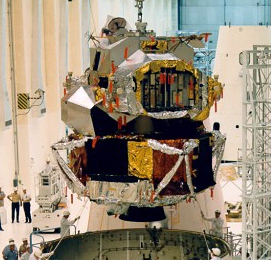Apollo 5
|
|
| Mission Insignia | |
|---|---|
| Missing image LM1_embr_original.jpg LM-1 Insignia | |
| Mission Statistics | |
| Mission Name: | Apollo 5 |
| Call Sign: | AS-204 |
| Launch: | January 22, 1968 22:48:09 UTC Cape Canaveral Complex 37B |
| End of Mission: | January 23, 1968 ~09:58:00 UTC |
| Duration: | 11 h 10 min |
| Number of Orbits: | 7.5 |
| Apogee: | 133 mi (214 km) |
| Perigee: | 100.7 mi (162 km) |
| Period: | 89.5 min |
| Inclination | 31.6 deg |
| Distance Traveled: | ~190,000 mi (300,000 km) |
| Mass: | 14,360 kg |
| AS-204 | |
Apollo 5 was the first unmanned flight of the Apollo Lunar Module that landed man on the Moon.
| Contents |
Objectives
This was the first flight of the Lunar Module and as such was basically a systems test. This would be the first firings of the descent and ascent engines in space. The descent engine was also the first throttleable rocket engine fired in space.
Also there would be a 'fire in the hole' test where the ascent engine was fired while still attached to the descent stage. This would simulate the conditions experienced during an abort during descent to the lunar surface.
Delays
As with Apollo 4, this flight experienced long delays. The primary cause of this was the Lunar Module. It was well behind schedule, though of course schedules are based on previous experience and nobody had ever built a manned spacecraft to land on the Moon.
It had been planned to launch Apollo 5 in April 1967 and so delivery at the Cape was hoped for around September 1966. But delays kept occurring. Although the lunar module was fully designed, there was trouble fabricating the custom made parts. The all important engines were also having problems. The descent engine was not burning smoothly and the ascent engine was having fabrication and welding difficulties.
In the end these problems were overcome but it took several months and it wasn't until 23 June 1967 that the Lunar Module arrived at the Cape onboard Aero Spacelines' Super Guppy. After four months of tests and repair the Lunar Module was mated to the launch vehicle on 19 November.
On 17 December 1967, a LM test failed in the Grumman ascent stage manufacturing plant. A window in LM-5 (Apollo 11's LM "Eagle") shattered during its initial cabin pressurization test, designed to pressurize the cabin to 39 kilopascals (5.7 lbf/in²). Both inner and outer windows and the plexiglass cover of the right-hand window shattered when the pressure reached 35 kPa (5.1 lbf/in²).
On 28 December 1967 a decision was made to replace the glass windows in LM-1 with aluminum windows, as a precaution against a failure in flight similar to the one that occurred on LM-5 in testing.
Flight
The launch vehicle for Apollo 5 was the Saturn IB, a smaller rocket than the Saturn V but capable of launching an Apollo spacecraft into Earth orbit. The Saturn IB AS-204, that was used on Apollo 5 was the one originally intended for Apollo 1. It was undamaged in the fire that killed the crew and so it was decided to reuse it. The Apollo 1 fire took place at Launch Complex 34. The AS-204 Saturn Ib was taken down from Complex 34 and reassembled at Launch Complex 37B for the Apollo 5 launch.
LM-1 lacked two important things for a lunar landing - legs and glass windows. It had been decided that to shorten the delivery time for the Lunar Module that the first test flight would not have legs. There was no need for them in Earth orbit though there was a feeling around NASA that the fewer versions of a spacecraft created the better. The windows of LM-1 were replaced before the flight with solid aluminum plates. The windows on another LM had failed in ground pressure tests shortly before the flight of LM-1. NASA decided to replace the LM-1 windows with solid aluminum plates to preclude an in flight failure until the root problem could be found. Since the LM-1 had no crew, it could do without windows. The rocket also didn't feature a launch escape system, meaning it was only 55 metres tall.
Finally on January 22, 1968, eight months after the planned launch date, Apollo 5 lifted off just before sunset. The Saturn IB worked perfectly, inserting the second stage and LM into a 163 x 222 km orbit. The Lunar Module separated 45 minutes later and then two orbits later started a planned 39 second burn of its descent engine. This lasted for only 4 seconds however, after the guidance computer detected the spacecraft was not travelling fast enough. The cause was that the propellant tanks were only partially pressurised and it took longer than the programmed four seconds to reach full acceleration.
The ground controllers decided to move to an alternate plan. They turned off the guidance computer and started an automatic sequence programmed into the onboard computer. This fired the descent engine two more times. It then performed the fire-in-the-hole test and another ascent engine burn.
After four orbits the mission was over and the two stages were left to decay on into the Pacific several hundred kilometers southwest of Guam on 12 February.
The Apollo 5 LM ascent stage (1968-007A) decayed 24 January 1968. The LM descent stage (1968-007B) decayed 12 February 1968.
Insignia
This patch was not designed by NASA but by the engineers at Grumman Aircraft who designed and built the Lunar Module. It portrays the fire-in-the-hole test. It also shows the LM without landing gear and with the Moon in the top right.
External links
- Apollo 5 (http://nssdc.gsfc.nasa.gov/database/MasterCatalog?sc=1968-007A)
- Moonport: A History of Apollo Launch Facilities and Operations (http://www.hq.nasa.gov/office/pao/History/SP-4204/cover.html)
- Chariots for Apollo: A History of Manned Lunar Spacecraft (http://www.hq.nasa.gov/office/pao/History/SP-4205/cover.html)
- U.S. Space Objects Registry (http://usspaceobjectsregistry.state.gov/search/index.cfm)


